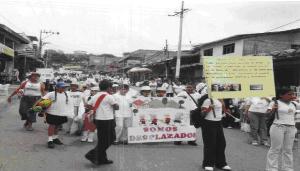|
|
Working for a Culture of Peace in the Valley of the Cauca, Colombia
un article par Ramiro Ovalle Yanes
During the past seven years I have been directing a project called the PEACE CHAIR ("CÁTEDRA DE PAZ") in the department of the Valley of the Cauca, Colombia. Its objective is the construction of a peace culture, based on respect for human rights, the fulfillment of duties, the founding of a citizen culture and the peaceful resolution of conflicts in the schools.
The project is directed at 200,000 students of pre-school, primary and baccalaureate. With my work team at the Secretariat of Education (we are 3), we have prepared 9000 teachers to be multipliers of the project in each school. All the teachers have received all the training, and they go back to their schools, bringing the project to their colleagues and to the students.

"We do these parades in the narcos and guerrilla zone, with our teachers and students."
(click on photo to enlarge)
One of the special missions is to establish mediation centers in each school. We enter in stage six of the program. These centers involve some teachers but they must be formed by the students themselves from the third to the eleventh grade. The students acquire training, using material that we provide to them, and little by little they acquire a peace culture.
Every year we incorporate something new. This year we are including a number of required subjects for the schools of Colombia. They are sex education, prevention of drug use, disaster prevention, free time, recreation, sports, environmental education, democracy and solidarity, and culture that has been brought from Africa. All this must have a component of living together in peace ("convivencia en paz").
The results have been very good. But it has not been easy because we are attacking the culture of drug trafficking, the guerrilla and the paramilitary, and we have done it with limited resources, our own money and my car and the help of the teachers. It is in the interest of all the people who inhabit our Valley. We have fought with our work and in a very cautious way against the narco-traffickers and the guerrillas.
We have the experience of the narco-trafficker called Don Diego, who has since been extradited, and whom we had to contest in the school ACERG, which was only one kilometer from where the bandit lived. With the Director of the school we never accepted assistance from him, even though he said that he could construct the classrooms that we needed. We told the Director we were sure that the State would help us and we have prevailed. It is a humble school in a mountainous zone, where there are still bandits remaining. This work has been kept quiet and known only by our teachers. The Director organized the community to develop workshops to make clothing and other kinds of cultivation as a source of income, and this has provided an alternative to the idea of narco-trafficking and guerilla warfare. It's been a very good experience.
At the moment we are expecting to obtain some economic aid from the catholic schools of Philadelphia in the USA, because in September when we initiate the scholastic year, we want to give school supplies and clothing to the children since we are in cold climate.
This is a brief summary of our work. I am attaching some of our publications and will appreciate your comments [editor's note: the documents CONCURSO and DERECHOS HUMANOS DEFINITIVO can be sent to interested readers by request to the CPNN coordinator]. I hope that someday your readers can come this way and learn first-hand of this good experience. God is our witness.
|








|
DISCUSSION
Question(s) liée(s) à cet article:
What's happening in Colombia?, Is peace possible?
* * * * *
Commentaire le plus récent:
The force of non-violence constrains the force of arms!
Colombia - the force of peaceful resistance -
At the beginning of July, the rebels of the armed revolutionary forces of Colombia (FARC) kidnapped a 51 year old Swiss, and his Colombian assistant who worked in the Indian communities of Cauca province where they were setting up development projects by building schools and community production enterprises.
The news of the kidnapping was spread through all the villages and 2000 Indians set out to pursue the 400 guerillas. They reached them at an elevation of over 4000 meters (12,000 feet), encircled them, and without any weapon, constrained them to release the 2 hostages! (After 2 days, the hostages were released).
This release, obtained through "peaceful resistance" has raised a national debate: the possibility of resisting violence without needing to use weapons has demonstrated the effectiveness of human solidarity movements.
"I will return, and I will then be millions" prophesied the Aymara Indian leader Tapak Katari, in 1781, at the time of his execution by the Spanish conquistadors.
100 million in 1492, the Indians were no more than 4,5 million one century and half later. Currently there are 44 million Indians populating Latin America.
In spite of their great diversity, the Indian movements take on more and more importance. In Ecuador, Guatemala, Bolivia, Peru, Mexico or Colombie they are opposed to the neoliberal system that governs the Americas, while protesting against the imposition of the American economic market. . ... continuation.

|
|









